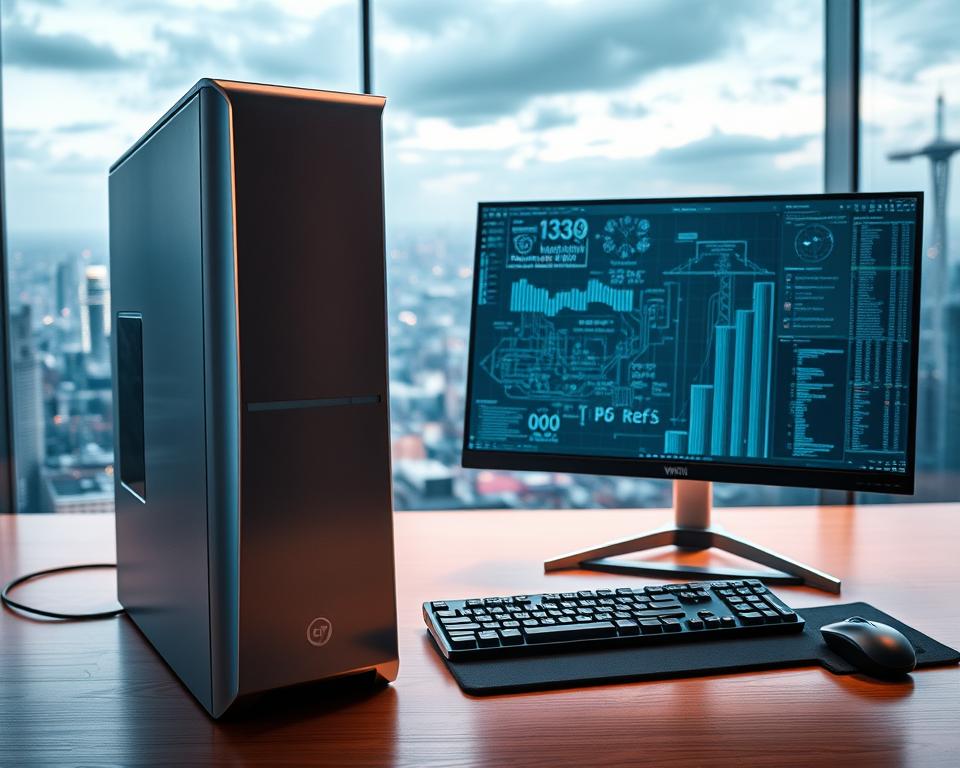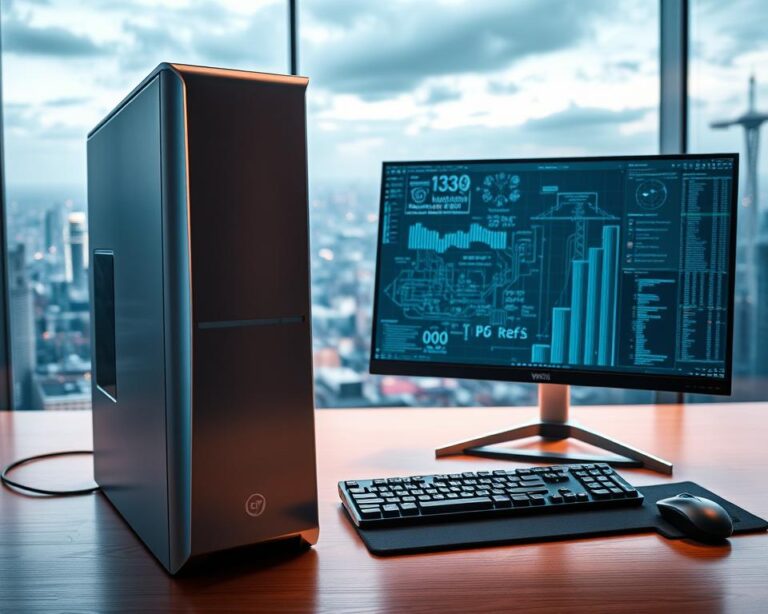
Everything You Need to Know About Computer Tech
Did you know that the global spending on information technology is projected to reach a staggering $4.5 trillion in 2023? This massive investment underscores the importance of understanding the intricacies of computer technology, as it is more than just a tool; it’s an integral part of our everyday lives. In this comprehensive guide, we’ll delve into essential aspects of computer technology—from foundational components and systems to the latest digital innovations and computer science updates. Whether you’re a seasoned enthusiast or just getting started, you’ll find insights that enhance your knowledge and appreciation of this dynamic field.

Key Takeaways
- Understand the evolution of computers from vacuum tubes to modern microchips.
- Differentiate between various types of computer systems, including desktops and mobile devices.
- Explore the key components of a computer, such as the CPU and motherboard.
- Gain insights into the different operating systems available today.
- Stay updated on the latest tech trends and the future of computer technology.
- Learn about the significance of cybersecurity in today’s digital age.
Introduction to Computer Technology
Computer technology is an integral aspect of modern life, shaping how we communicate, learn, and work. This introduction to tech serves as a gateway to understanding the critical role computers play in various sectors, including healthcare, education, and business. A grasp of computer basics equips individuals to navigate and make the most of the digital landscape.
The significance of about computer technology information cannot be overstated. In today’s world, familiarity with technology enables efficient information processing, enhances communication, and drives innovative solutions. As technology continues to evolve, staying informed empowers individuals and organizations to adapt and thrive in an increasingly digital environment.
Understanding the fundamentals of computer technology lays the groundwork for deeper exploration into specific applications and trends. Recognizing how technology impacts everyday experiences is essential for anyone looking to harness its full potential.

The Evolution of Computers
The journey of computer evolution is a fascinating tale of transformation and technological advancement. It began with the bulky vacuum tubes that powered some of the earliest computing machines. As innovation sparked new ideas, these rudimentary components gave way to the development of microchips, revolutionizing how data is processed and stored.
From Vacuum Tubes to Microchips
The transition from vacuum tubes to microchips marked a significant milestone in computing history. Vacuum tubes were large, fragile, and consumed considerable power. In contrast, microchips entered the scene, allowing computers to become more compact, efficient, and reliable. This critical advancement paved the way for a new era in electronics, where devices could become more accessible to the general public.
The Rise of Personal Computers
The introduction of personal computers in the late 20th century changed the landscape of computing. Early models like the Altair 8800 and the Apple I made this powerful technology available to enthusiasts and businesses alike. As microchips became more sophisticated, personal computers grew in popularity and effectiveness, ultimately leading to their integration into everyday life. This shift illustrated the impact of technological advancement, where computers moved from elaborate tools used by scientists to essential devices found in homes across America.

Types of Computer Systems
Understanding the diverse types of computer systems allows users to select devices fitting their needs. This section outlines the key distinctions among desktops and laptops, explores the realm of server technology, and highlights the rising significance of mobile devices.
Desktops vs. Laptops
represent two primary categories of personal computers, each catering to different user preferences. Desktops typically offer greater processing power and larger displays, making them ideal for gaming and creative tasks. Users often appreciate their upgradeability and affordability. Laptops, on the other hand, prioritize portability. They combine convenience with efficiency, allowing users to work or play on the go.
Servers and Mainframes
Server technology plays a crucial role in managing and storing data for businesses of all sizes. Servers are designed to handle multiple requests simultaneously, providing resources to users across a network. Mainframes, although less common in smaller enterprises, deliver massive processing capabilities, handling vast amounts of data for industries such as banking and healthcare.
Mobile Devices and Tablets
Mobile devices, including smartphones and tablets, have transformed how people interact with technology. These portable computer systems emphasize connectivity and user-friendly interfaces. Tablets bridge the gap between laptops and smartphones, offering an accessible platform for work and entertainment. The rise of these mobile devices reflects a shift towards flexibility, catering to the demands of a fast-paced lifestyle.

Understanding Computer Components
In the world of computers, the essence lies in understanding the various computer components that contribute to a system’s performance and functionality. Delving into the core elements like the CPU, memory, and storage options reveals their pivotal roles in determining how efficiently a computer operates. This section explores these essential elements in detail, highlighting their significance within any computing environment.
The Role of the CPU
The Central Processing Unit (CPU) functions as the brain of a computer, executing instructions and processing data. Its speed and efficiency are critical for tasks ranging from simple operations to complex computations. Modern CPUs from brands such as Intel and AMD are designed to perform multiple tasks simultaneously, enhancing overall system performance. Understanding the specifications of a CPU can help users select a processor that aligns with their computing needs.
Memory: RAM and Storage Options
Memory plays a crucial role in a computer’s operation. Random Access Memory (RAM) temporarily holds data that the CPU needs while performing tasks. Higher RAM capacity allows for smoother multitasking and faster performance. When it comes to storage, options vary between Hard Disk Drives (HDD) and Solid State Drives (SSD). Both have their benefits: HDDs offer larger storage at a lower cost, while SSDs provide faster data access speeds. Knowing the differences between these types of memory and storage can assist users in making informed decisions about their computer’s configuration.
Motherboard: The Heart of the Computer
The motherboard serves as the foundation, connecting all major computer components. It allows communication between the CPU, memory, and storage devices. A well-designed motherboard can support various features, including expansion slots for graphics cards and additional memory. Users should consider compatibility with other components, as this will impact the overall performance and future upgrades of their systems.

Operating Systems Explained
Operating systems serve as the backbone of computer technology, managing hardware and software resources while providing an interface for users. Understanding different operating systems is essential for anyone looking to navigate the world of computing. This section delves into a comparison of popular operating systems, particularly focusing on Windows, macOS, and a Linux overview, as well as mobile operating systems.
Windows and macOS dominate the desktop market, each offering unique features and user experiences. Windows, known for its widespread compatibility and extensive software offerings, appeals to gamers and business users alike. In contrast, macOS emphasizes aesthetics and seamless integration with Apple’s ecosystem, attracting creative professionals and everyday consumers. The Linux overview reveals a different landscape, characterized by customization and openness, making it a preferred choice for developers and tech enthusiasts.
| Feature | Windows | macOS | Linux |
|---|---|---|---|
| User Interface | Highly customizable | Sleek and cohesive | Varies by distribution |
| Software Availability | Extensive | Moderate, tailored for creatives | Rich in open-source options |
| Security | Vulnerable to malware | Generally robust | Strong, with multiple layers of protection |
| Cost | Paid | Paid | Free and open-source |
Mobile Operating Systems
In the realm of mobile devices, two leading players dominate: Android and iOS. Android, with its open-source nature, has an extensive ecosystem of apps and custom ROMs. This flexibility attracts a diverse user base. iOS, on the other hand, delivers a polished and secure experience within the Apple ecosystem, maintaining a loyal customer segment. Understanding the differences in these mobile operating systems is crucial for anyone considering a smartphone or tablet choice.
Networking Basics
Understanding networking basics is essential for anyone looking to grasp the fundamentals of computer networking. Networking allows various devices to connect, share, and communicate efficiently. Key concepts include Local Area Networks (LAN) and Wide Area Networks (WAN), which serve different purposes depending on the geographical scope.
At the heart of effective computer networking are routers and switches. Routers manage data traffic between networks, while switches connect devices within the same network. These components are crucial for ensuring smooth internet connectivity and enhancing communication between multiple devices.
Network security also plays a significant role in maintaining the integrity of a network. With threats like data breaches and unauthorized access on the rise, implementing security protocols is more important than ever. This helps keep your internet connectivity safe and reliable, protecting sensitive information from potential hackers.
About Computer Technology Information
Staying informed about computer technology information is crucial for anyone interested in the tech landscape. Numerous resources exist to help enthusiasts and professionals alike keep up with the rapid pace of change. News outlets such as TechCrunch and Wired offer a wealth of articles covering the latest tech updates, providing insights into new products, software updates, and industry shifts.
In addition to traditional news sources, many specialized websites and blogs focus on specific areas of technology. For example, Ars Technica and The Verge delve into both hardware and software topics, while publications like MIT Technology Review highlight groundbreaking research and innovation in the tech realm. These platforms serve as vital channels for accessing tech industry insights that can aid in decision-making and future investments.
Subscribing to newsletters and podcasts can further enhance your understanding of current trends and emerging technologies. Various tech-focused platforms, like Slashdot, aggregate news from multiple sources, making it easier to spot noteworthy updates. Staying engaged with the community through forums can open doors to valuable discussions. By actively seeking out about computer technology information, individuals can equip themselves with the tools necessary to navigate the dynamic world of technology.
Latest Tech Trends in 2023
The world of technology is constantly evolving, with significant advancements shaping how we live and work. In 2023, the latest tech trends focus on innovative applications of AI and machine learning, alongside transformative developments in cloud computing. Businesses and organizations are leveraging these technologies for enhanced efficiency and improved customer experiences.
Artificial Intelligence and Machine Learning
AI and machine learning have made substantial inroads across various sectors. Companies utilize these technologies to analyze extensive data sets, enabling informed decision-making and predictive analytics. Notable advancements include:
- Natural Language Processing improvements, enhancing customer interaction through chatbots and virtual assistants.
- Automated decision-making systems, streamlining operations and reducing human error.
- Personalized user experiences, driven by tailored recommendations based on user behavior.
Cloud Computing Advancements
Cloud computing continues to revolutionize how businesses manage resources. Cutting-edge solutions facilitate flexibility and scalability, essential for growth in today’s market. Key advancements include:
- Increased security measures, providing robust data protection.
- Hybrid and multi-cloud strategies, allowing organizations to optimize workloads across various platforms.
- Enhanced integration of AI capabilities, enabling smarter cloud applications.
Digital Innovations Reshaping Industries
Digital innovations bring significant changes to various sectors, notably in healthcare and education. These advancements enhance the way professionals and consumers interact with services. By incorporating technology into everyday processes, industries realize improved efficiency and effectiveness.
Impact of Tech on Healthcare
The tech impact on healthcare has been transformative. Telemedicine platforms enable patients to consult with doctors from the comfort of their homes, expanding access to care. Health tracking applications encourage users to monitor their wellness proactively. These tools not only enhance patient engagement but also lead to better health outcomes.
Transforming Education Through Technology
Education technology revolutionizes the learning experience. Online learning platforms provide students with flexible access to course materials and resources. E-books and interactive learning tools foster a more engaging environment, allowing personalized education routes. As a result, these digital innovations empower educators and learners alike, paving the way for a more efficient educational landscape.
IT News Updates: What to Watch For
As the tech landscape continuously evolves, staying informed about the latest IT news updates becomes essential for professionals and enthusiasts alike. Emerging technologies such as blockchain and 5G are at the forefront of innovation, promising significant improvements across various sectors. Keeping an eye on these developments can provide valuable insights into future trends and business strategies.
Emerging Technologies to Follow
Several emerging technologies have the potential to disrupt traditional industries. Notably, artificial intelligence and machine learning continue to evolve, offering powerful tools for data analysis and automation. Other noteworthy innovations include:
- Internet of Things (IoT): Enhancing connectivity between devices and creating smarter environments.
- Quantum Computing: Revolutionizing computing power and problem-solving capabilities.
- 5G Networks: Allowing faster data transmission and improved connectivity.
Industry Disruptions on the Horizon
Anticipating industry disruptions plays a critical role in strategic planning. Various sectors, particularly healthcare, finance, and retail, are poised for transformation through automation and advanced data analytics. Noteworthy trends include:
- Increased use of telemedicine in healthcare services, improving patient care and accessibility.
- Blockchain technology transforming transactional methods in the finance sector.
- Personalized customer experiences reshaping retail through data-driven insights.
Tech Industry Insights: Key Players
The tech industry continues to evolve, driven by significant contributions from both established firms and innovative startups. Understanding these key players provides valuable insights into market dynamics and technological advancements.
Major Companies Leading the Charge
Major tech companies such as Apple, Microsoft, and Google play a crucial role in setting trends and shaping the future of technology. Their investment in research and development enables them to introduce cutting-edge products and services. Notable efforts include:
- Apple: Focuses on enhancing user experience through sleek designs and integrated ecosystems.
- Microsoft: Leads in software solutions and cloud services, empowering businesses globally.
- Google: Dominates online services and has made significant advancements in artificial intelligence.
Startups to Keep an Eye On
Startups often bring fresh ideas and innovative solutions that challenge the status quo. Companies like SpaceX, Stripe, and Robinhood are noteworthy for their disruptive technologies. These startups are paving the way for:
- SpaceX: Revolutionizing space travel with cost-effective rocket technology.
- Stripe: Simplifying online payment processing, making e-commerce more accessible.
- Robinhood: Changing the investment landscape by democratizing stock trading.
Advancements in Computing Power
The landscape of computing power continues to evolve rapidly, showcasing impressive advancements that change how we interact with technology. These developments significantly enhance processing capabilities through quantum computing and modern processor technology. As researchers and engineers push the boundaries, we see transformative shifts across various fields, from scientific research to everyday applications.
Quantum Computing Breakthroughs
Quantum computing represents a groundbreaking shift in computing power advancements, enabling unprecedented speeds and efficiencies. Traditional binary processing limitations may soon become a thing of the past. Companies like IBM and Google are at the forefront, creating quantum systems capable of solving complex problems that classical computers struggle with. This leap into quantum computing allows for advancements in cryptography, optimization, and data analysis, presenting a new realm of possibilities for innovation.
Improving Processor Speeds
Processor technology has seen extraordinary growth over the past few years. The industry aggressively focuses on enhancing chipsets to maximize performance. Notable hardware manufacturers, including Intel and AMD, have introduced new architectures that prioritize speed and energy efficiency. Concurrently, techniques such as multi-core processing and hyper-threading significantly improve computational tasks. This rapid evolution leads to smoother user experiences, more powerful applications, and better multitasking capabilities, further emphasizing the importance of constant advancements in computing power.
Computer Security Fundamentals
In today’s digital landscape, understanding computer security holds significant weight in safeguarding personal and organizational information. With the rapid integration of technology into daily life, the importance of cybersecurity cannot be overstated. Individuals and businesses alike must remain vigilant against various threats that jeopardize sensitive data.
Importance of Cybersecurity
Cybersecurity serves as the backbone of modern technology, ensuring that networks, devices, and data are protected from unauthorized access and attacks. As cyber threats become more sophisticated, the importance of cybersecurity grows. Organizations must invest in robust security measures to protect not only their data but also their reputations and customer trust.
Common Threats to Awareness
Being aware of common threats helps in developing effective strategies to combat them. The following table outlines some frequent cybersecurity risks:
| Threat Type | Description | Potential Impact |
|---|---|---|
| Phishing | Fraudulent attempts to obtain sensitive information via deceptive emails or websites. | Data theft, financial loss, identity fraud. |
| Ransomware | Malware that encrypts files, demanding a ransom for decryption. | Loss of access to critical data, financial loss. |
| Malware | Any software designed to harm, exploit, or otherwise compromise a system. | Data corruption, theft, disruption of services. |
Enhanced awareness of these common threats fosters better preparedness and response strategies. By prioritizing computer security, individuals and organizations can significantly reduce the risks associated with cyber threats, ensuring the safety of their valuable information.
Resources for Computer Technology Enthusiasts
Expanding knowledge in computer technology can be an exciting journey. Many individuals seek out reputable computer technology resources that provide access to valuable online courses and certifications. With the right materials, anyone can enhance their skills and stay updated in this ever-evolving field.
Online Courses and Certifications
A variety of platforms offer comprehensive online courses that cater to different skill levels. Websites like Coursera, edX, and Udemy feature courses on programming, cybersecurity, and data science. Many of these platforms also provide certification upon completion, adding credibility to one’s skillset. These certifications often help individuals stand out in a competitive job market.
Websites and Blogs for Tech Updates
For those who prefer reading, tech blogs serve as excellent resources. Sites like TechCrunch, Wired, and Ars Technica cover the latest trends, devices, and innovations in the tech world. Following these blogs not only keeps enthusiasts informed but can also inspire new ideas and projects. Regular updates help readers stay current with industry changes, making these blogs vital for keen learners in computer technology.
Future of Computer Technology
The landscape of computer technology is ever-evolving, driven by a relentless wave of innovation. The future of technology hinges on breakthroughs that enhance computing capabilities and reimagine user experiences. As we look ahead, several key tech innovations promise to redefine how we interact with systems and data.
The Role of Innovation in Tech
Innovation remains a central theme as we explore the potential of next generation computing. This includes advancements in artificial intelligence, machine learning, and their integration into everyday applications. With each technological leap, we witness increased efficiency and smarter connectivity in devices.
Consider the growing importance of AI in decision-making processes across various sectors. As companies adopt machine learning algorithms, they create systems capable of learning from data patterns, allowing for more accurate predictions and improved services.
Below is a table showcasing some of the most promising tech innovations on the horizon:
| Technology | Expected Impact | Potential Applications |
|---|---|---|
| Quantum Computing | Revolutionizing data processing speeds | Crytography, complex simulations |
| Augmented Reality | Enhancing immersive experiences | Training, gaming, retail |
| 5G Connectivity | Improving communication speed | IoT devices, smart cities |
| Brain-Computer Interfaces | Facilitating direct communication | Medical rehabilitation, augmented interaction |
As technological advancements continue to unfold, the future of technology invites users and developers alike to engage with these innovations. The interplay of creativity and science underpins the next generation of computing, paving the way for a smarter, more efficient world.
Conclusion
As we wrap up this exploration of computer technology, it’s crucial to reflect on the key takeaways outlined in this article. Understanding the evolution and diverse types of computer systems provides a solid foundation, enabling us to grasp the intricacies behind the fast-paced tech landscape. Maintaining an awareness of technological advancements empowers us to adapt to ongoing changes and innovations.
This summary of tech insights not only highlights the importance of knowing about computer technology information but also encourages readers to stay curious and engaged. By continually exploring new resources, such as online courses and blogs, individuals can enhance their understanding and connection to the latest trends in the computing world.
Ultimately, the future of computer technology is ripe with innovation and potential. Staying informed is not just beneficial but essential for anyone looking to navigate this dynamic field successfully. Embrace your journey into the ever-evolving realm of technology, and let your curiosity lead the way!



